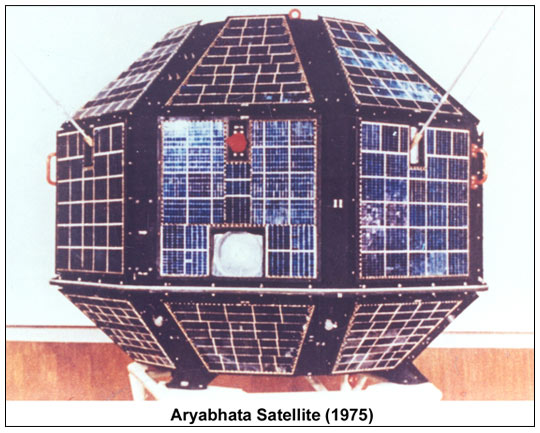ARYABHATA

The Aryabhata spacecraft, named after the famous Indian astronomer, was India's first satellite; It was completely designed and fabricated in India. It was launched by a Soviet Kosmos-3M rocket from Kapustin Yar on April 19, 1975. Aryabhata spacecraft was commemorated by stamping its imprint on the Indian 2 rupee bank note from 1976 to 1997.
The spacecraft was quasispherical in shape containing 26 sides and carried three experiments for the measurement of cosmic X-rays, solar neutrons, and Gamma rays, together with a sensor for the study of the Ionosphere. The spacecraft weighed 360 kg, used solar panels on 24 sides to provide 46 W of power, used a passive thermal control system, carried Ni-Cd batteries, and a spin-up gas jet system to provide a spin rate of not more than 90 rpm. There was a set of altitude sensors comprising of a tri-axial magnetometer, a digital elevation solar sensor and four azimuth solar sensors. The data system included a tape recorder at 256 bits per second with playback at 10 times that rate. The PCM-FM-PM telemetry system operated at 137.44 MHz.
The launch was witnessed by Chairman, ISRO, Prof.S.Dhawan at Kapustin Yar, USSR. The necessary ground telemetry and telecommand stations were established at SHAR Centre in Sriharikota, Andhra Pradesh. The signals from the satellite were received at the Bears Lake Ground Station near Moscow and at a make-shift ground station at Peenya. The spin up system started its operations, six months after the launch. Only one payload could be operated for the first few orbits, due to a problem developed in the power distribution system. The full main frame of the satellite worked well and the satellite was tracked for 17 years before the orbital life ended. This satellite was one of the earliest ones to use CMOS devices on a large scale. The checkout system used Indian made TDC-12 computer with punched tape input/output devices.
Experiments were conducted on satellite ranging which demonstrated the tele-medicine concept in the elementary form by transmitting ECG signals from SHAR to Bangalore.
During the development phase, the satellite model roughly half in size of the final version was tested out on a balloon flown at about 25 km altitude on May 5,1973 from Hyderabad. Similarly the engineering model was carried aloft by a helicopter over Sriharikota during January 1975. Four models of the satellite were developed during a three year period by a young team which had no previous experience of making any space hardware.






